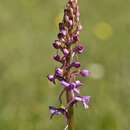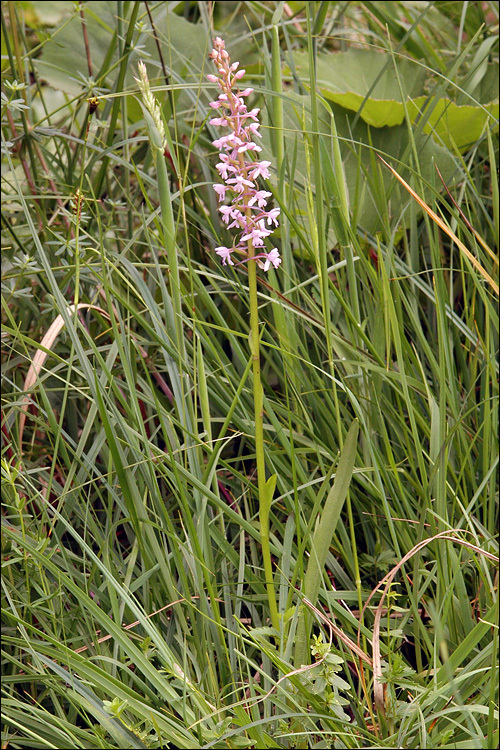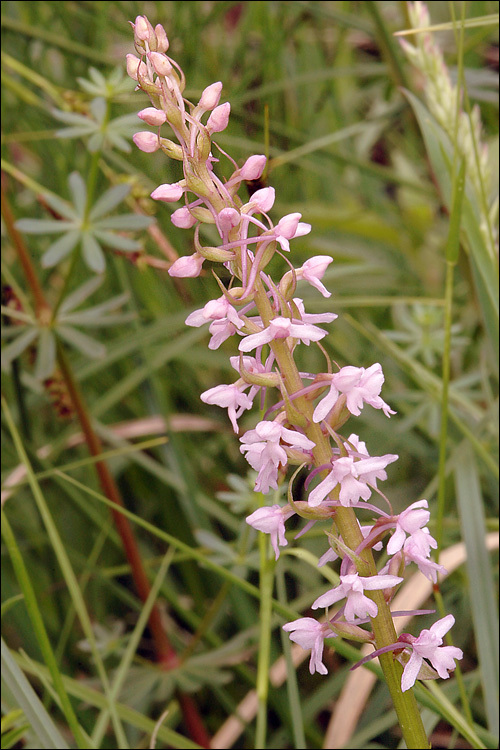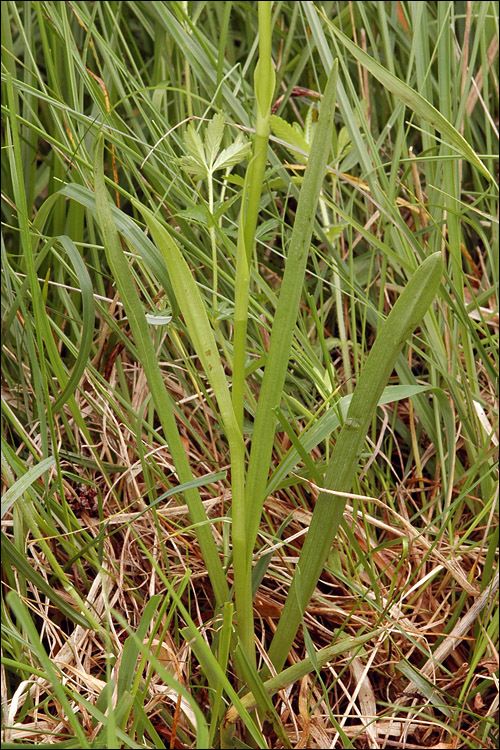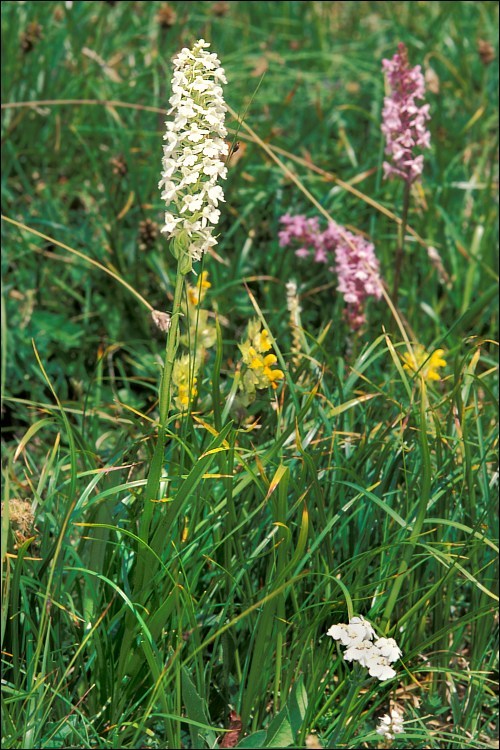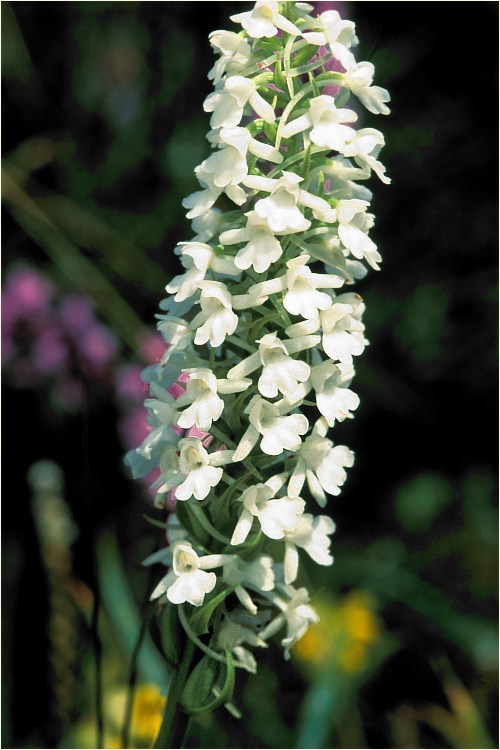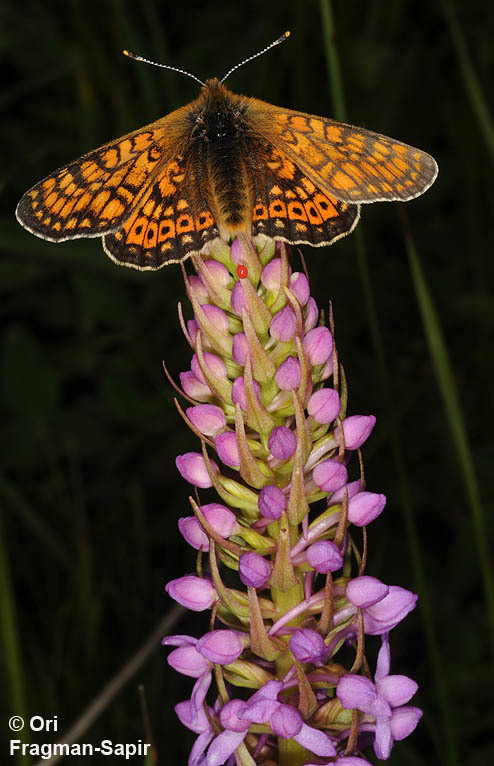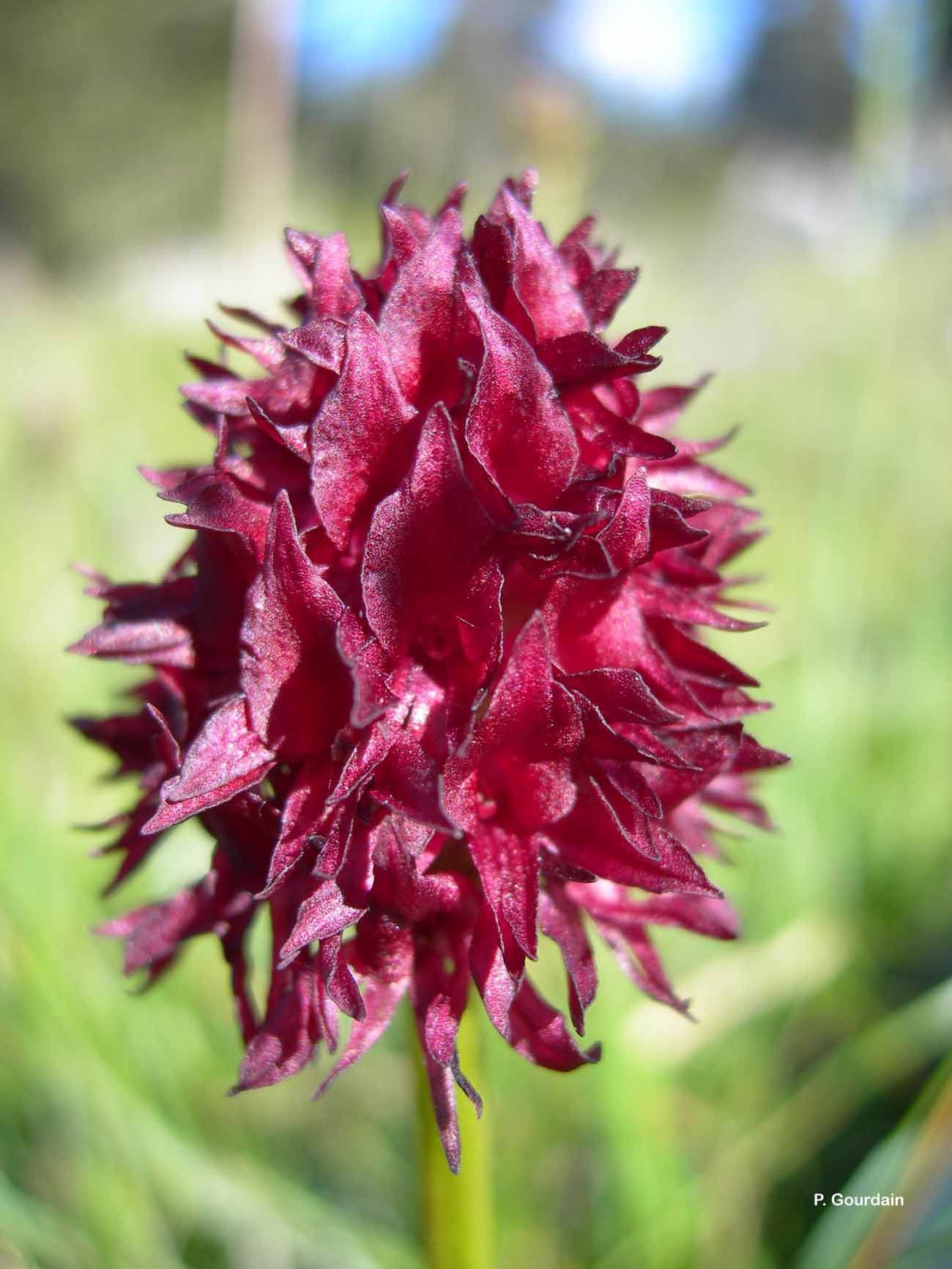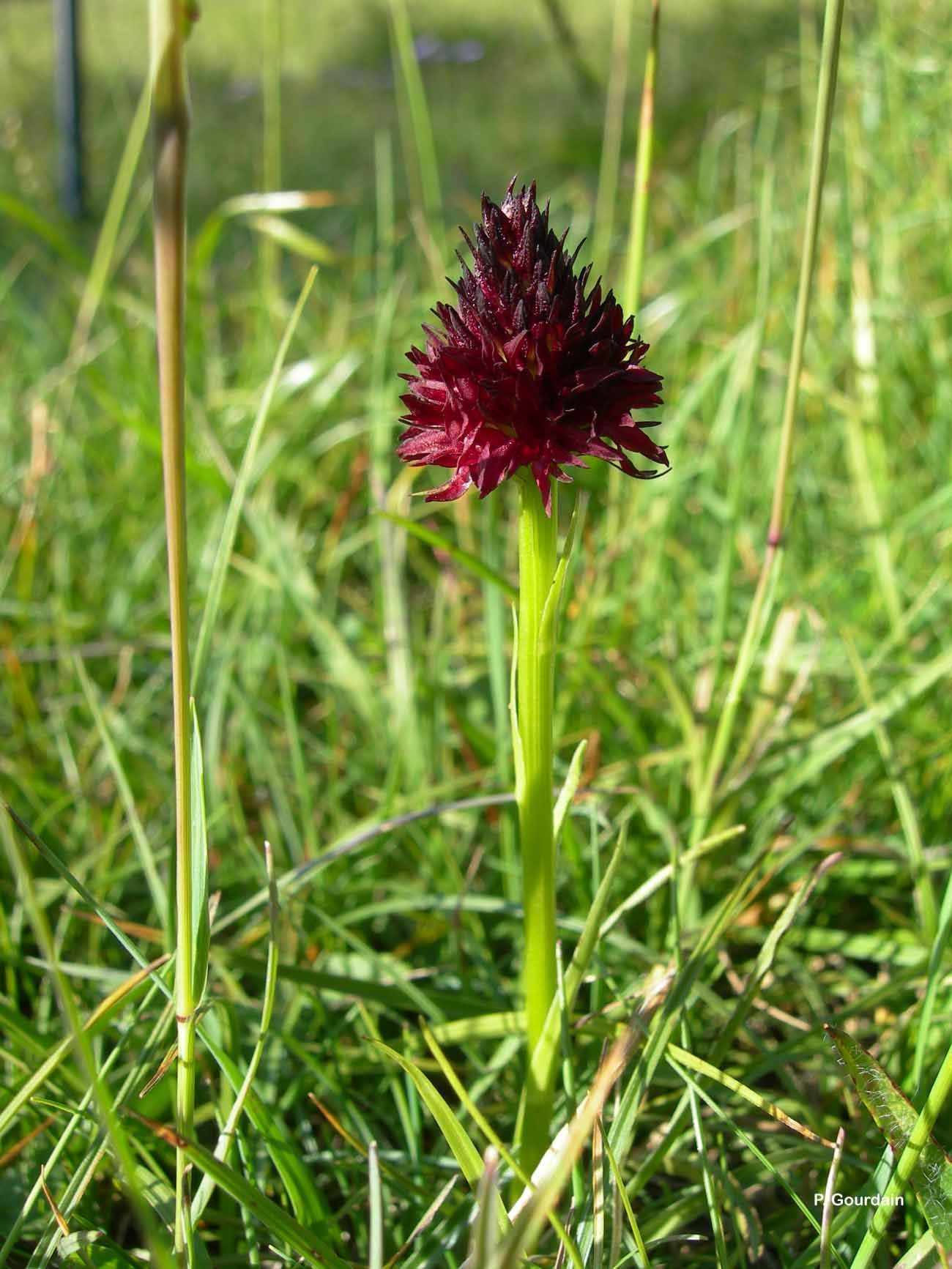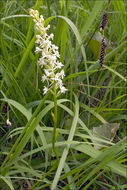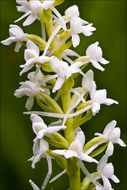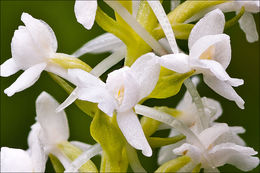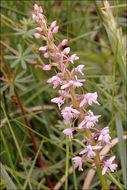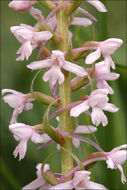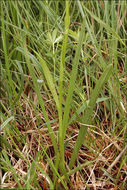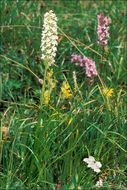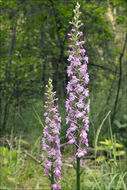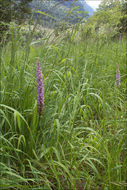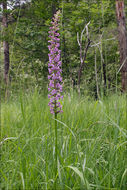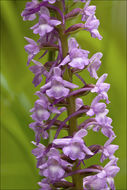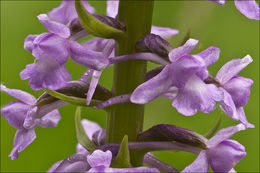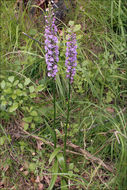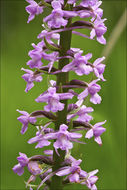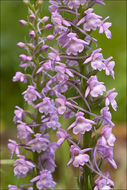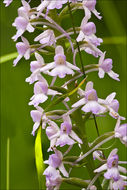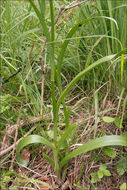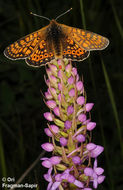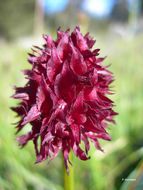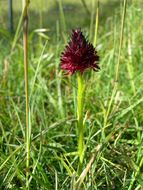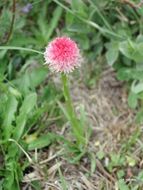-
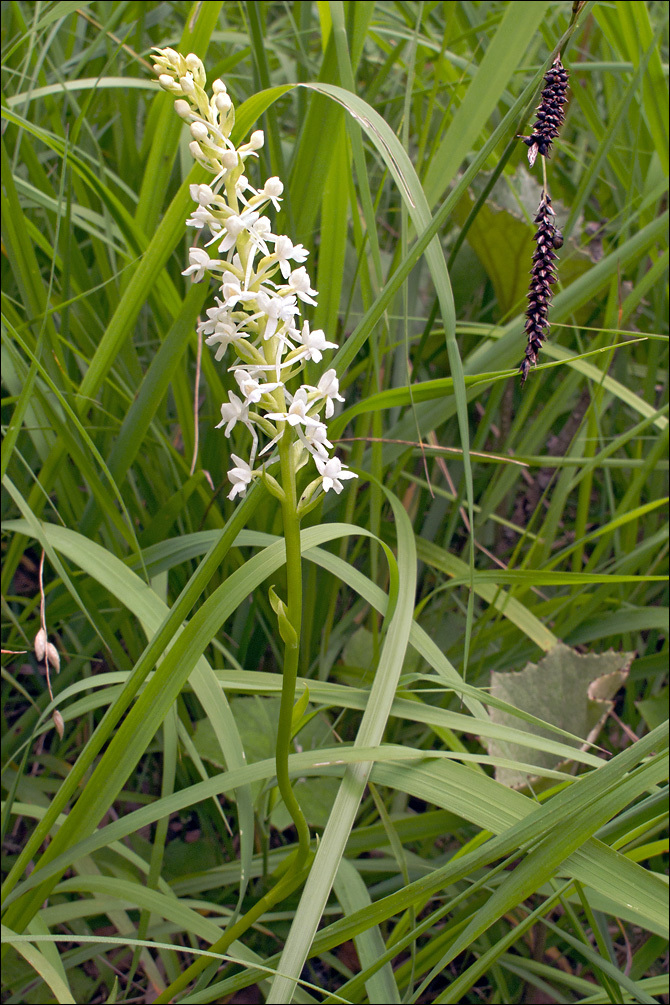
Slo.: navadni kukovinik, beli razliek - Habitat: grass and isolated trees (Picea abies and Fagus sylvaticadominant) overgrown young alluvial deposits of a river, calcareous ground, shallow ground water, flat terrain, open, fairly sunny place, high air and ground humidity, exposed to direct rain, average precipitations ~ 3.000 mm/year, average temperature 7-9 deg C,elevation 540 m (1.770 feet),alpine phytogeographical region. - Substratum: soil. - Comment: Gymnadenia conopsea and all its subspecies and variations are usually pinkish-reddish colored. All kinds of mostly pale shades of pink-red-violet color can be found in the field. But sometimes individual plants lack their color pigment completely and appear as an albino form completely white. Such instances are even not rare. It seems like loss of color is not a big deal for Gymnadenia conopsea. Already in 1793 German botanist Sprenger assumed that Gymnadenia conopsea must be pollinated predominantly during night by night moths. He based his suspect on plant's distinct smell and frequently pale unicolor flowers without attracting colorful decoration so common for other orchids. Vivid color and atrctive decoration would not help to attract pollinators when it is dark. Darwin confirmed Sprenger was right by his field observations 70 years later. Actually white or pink make little difference during the night.Usually such plants do not represent something significant in taxonomical terms. At most they can be treated as a white form - an albino - of a higher taxonomical rank. - Protected according to 'Uredba o zavarovanih prostoiveih rastlinskih vrstah', Ur.l.RS, t.46/2004 (Regulation on protected wild plants, Official gazette of Republic of Slovenia, No. 46/2004). Enlisted in the Slovene Red List of rare and endangered species, marked by 'V' representing a vulnerable species. - Ref.: (1) H. Haeupler, T. Muer, Bildatlas der Farn- und Bluetenpflazen Deutschlands, Ulmer (2000), p 705. (2) H. Baumann, S. Kuenkele, R. Lorenz, Orchideen Europas, Ulmer (2006), p 104. (3) D. Aeschimann, K. Lauber, D.M. Moser, J.P. Theurillat, Flora Alpina, Vol. 2., Haupt (2004), p 1112. (4) M.A. Fischer, W. Adler, K. Oswald, Exkursionsflora sterreich Liechtenstein, Sdtirol, LO Landesmuseen, Linz, Austria (2005), p 1041. (5) A. Martini et all., Mala Flora Slovenije, Tehnina Zaloba Slovenije (2007) (in Slovene), p 773.
-
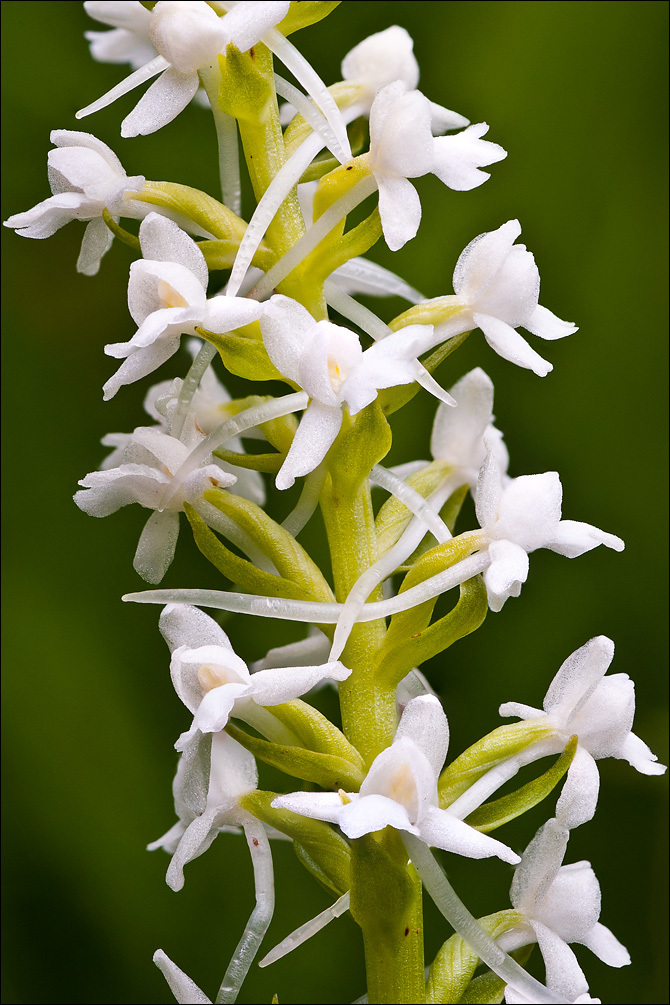
Slo.: navadni kukovinik, beli razliek - Habitat: grass and isolated trees (Picea abies and Fagus sylvaticadominant) overgrown young alluvial deposits of a river, calcareous ground, shallow ground water, flat terrain, open, fairly sunny place, high air and ground humidity, exposed to direct rain, average precipitations ~ 3.000 mm/year, average temperature 7-9 deg C,elevation 540 m (1.770 feet),alpine phytogeographical region. - Substratum: soil. - Comment: Gymnadenia conopsea and all its subspecies and variations are usually pinkish-reddish colored. All kinds of mostly pale shades of pink-red-violet color can be found in the field. But sometimes individual plants lack their color pigment completely and appear as an albino form completely white. Such instances are even not rare. It seems like loss of color is not a big deal for Gymnadenia conopsea. Already in 1793 German botanist Sprenger assumed that Gymnadenia conopsea must be pollinated predominantly during night by night moths. He based his suspect on plant's distinct smell and frequently pale unicolor flowers without attracting colorful decoration so common for other orchids. Vivid color and atrctive decoration would not help to attract pollinators when it is dark. Darwin confirmed Sprenger was right by his field observations 70 years later. Actually white or pink make little difference during the night.Usually such plants do not represent something significant in taxonomical terms. At most they can be treated as a white form - an albino - of a higher taxonomical rank. - Protected according to 'Uredba o zavarovanih prostoiveih rastlinskih vrstah', Ur.l.RS, t.46/2004 (Regulation on protected wild plants, Official gazette of Republic of Slovenia, No. 46/2004). Enlisted in the Slovene Red List of rare and endangered species, marked by 'V' representing a vulnerable species. - Ref.: (1) H. Haeupler, T. Muer, Bildatlas der Farn- und Bluetenpflazen Deutschlands, Ulmer (2000), p 705. (2) H. Baumann, S. Kuenkele, R. Lorenz, Orchideen Europas, Ulmer (2006), p 104. (3) D. Aeschimann, K. Lauber, D.M. Moser, J.P. Theurillat, Flora Alpina, Vol. 2., Haupt (2004), p 1112. (4) M.A. Fischer, W. Adler, K. Oswald, Exkursionsflora sterreich Liechtenstein, Sdtirol, LO Landesmuseen, Linz, Austria (2005), p 1041. (5) A. Martini et all., Mala Flora Slovenije, Tehnina Zaloba Slovenije (2007) (in Slovene), p 773.
-
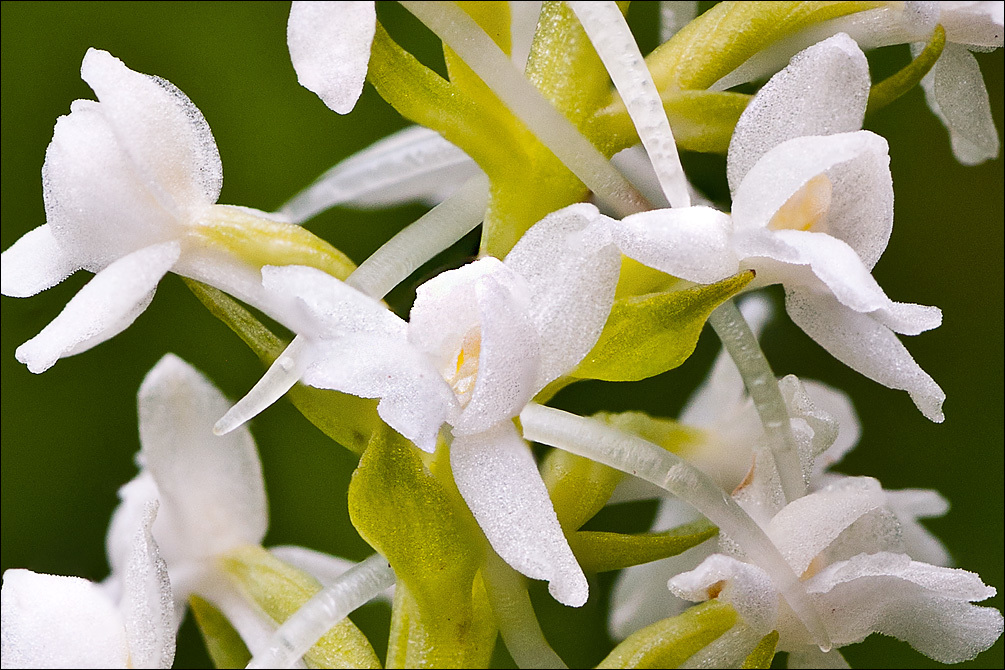
Slo.: navadni kukovinik, beli razliek - Habitat: grass and isolated trees (Picea abies and Fagus sylvaticadominant) overgrown young alluvial deposits of a river, calcareous ground, shallow ground water, flat terrain, open, fairly sunny place, high air and ground humidity, exposed to direct rain, average precipitations ~ 3.000 mm/year, average temperature 7-9 deg C,elevation 540 m (1.770 feet),alpine phytogeographical region. - Substratum: soil. - Comment: Gymnadenia conopsea and all its subspecies and variations are usually pinkish-reddish colored. All kinds of mostly pale shades of pink-red-violet color can be found in the field. But sometimes individual plants lack their color pigment completely and appear as an albino form completely white. Such instances are even not rare. It seems like loss of color is not a big deal for Gymnadenia conopsea. Already in 1793 German botanist Sprenger assumed that Gymnadenia conopsea must be pollinated predominantly during night by night moths. He based his suspect on plant's distinct smell and frequently pale unicolor flowers without attracting colorful decoration so common for other orchids. Vivid color and atrctive decoration would not help to attract pollinators when it is dark. Darwin confirmed Sprenger was right by his field observations 70 years later. Actually white or pink make little difference during the night.Usually such plants do not represent something significant in taxonomical terms. At most they can be treated as a white form - an albino - of a higher taxonomical rank. - Protected according to 'Uredba o zavarovanih prostoiveih rastlinskih vrstah', Ur.l.RS, t.46/2004 (Regulation on protected wild plants, Official gazette of Republic of Slovenia, No. 46/2004). Enlisted in the Slovene Red List of rare and endangered species, marked by 'V' representing a vulnerable species. - Ref.: (1) H. Haeupler, T. Muer, Bildatlas der Farn- und Bluetenpflazen Deutschlands, Ulmer (2000), p 705. (2) H. Baumann, S. Kuenkele, R. Lorenz, Orchideen Europas, Ulmer (2006), p 104. (3) D. Aeschimann, K. Lauber, D.M. Moser, J.P. Theurillat, Flora Alpina, Vol. 2., Haupt (2004), p 1112. (4) M.A. Fischer, W. Adler, K. Oswald, Exkursionsflora sterreich Liechtenstein, Sdtirol, LO Landesmuseen, Linz, Austria (2005), p 1041. (5) A. Martini et all., Mala Flora Slovenije, Tehnina Zaloba Slovenije (2007) (in Slovene), p 773.
-
Slo.: navadni kukovicnik
-
Slo.: navadni kukovicnik
-
Slo.: navadni kukovicnik
-
Slo.: navadni kukovicnik
-
Slo.: navadni kukovicnik
-
Slo.: navadni kukovicnik. Unusual albino species.
-
Slo.: navadni kukovicnik. Unusual albino species.
-
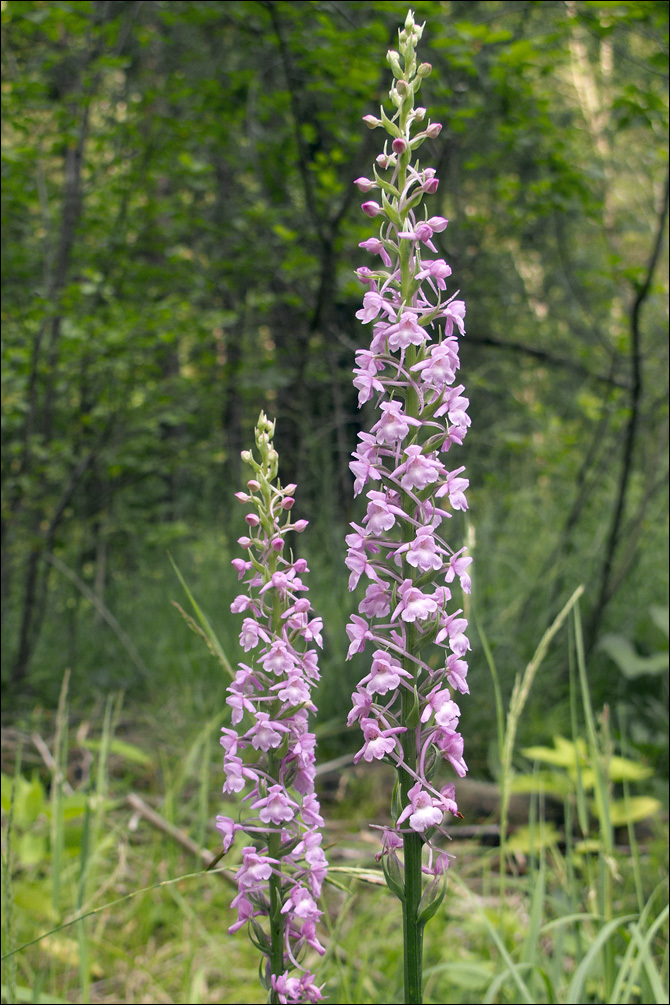
Slo.: navadni kukovinik - Habitat: grass and isolated trees (dominant Picea abies and Fagus sylvatica) overgrown alluvial deposits of a river, calcareous ground, shallow ground water, flat terrain, open fairly sunny place, high air humidity, exposed to direct rain, average precipitations ~ 3.000 mm/year, average temperature 7-9 deg C,elevation 540 m (1.770 feet), alpine phytogeographical region. - Substratum: soil. - Comment: Gymnadenia conopsea is with little doubt the most common wild orchid growing in upper Posoje. Many times it appears in large groups. One can find it almost in all habitats since it is ambivalent to ground humidity, acidity and type of ground. There is only one ground condition, which kills it - too much nitrogen in the ground, with other words too much fertilization particularly with nitrogen rich slurry. - Taxonomically, several subspecies, varieties and forms have been described, but most of them are not generally accepted. For example, tall plants with dense inflorescence and many flowers (>40 according to some authors) in it are named as Gymnadenia conopsea ssp. densiflora, Gymnadenia conopsea var. densiflora or lately on species level Gymnadenia splendida. Subspecies montana, alpina, vernalis etc. are also described. To my field experience plants differ widely in size, shape as well as in color (from pink to almost purple). On one hand, difference in habitus of a small Gymnadenia conopsea ssp. conopsea, say, 30 cm tall with 20 flowers and a plant, which is supposed to be Gymnadenia splendida, which can be over 1 m tall having very dense inflorescence with over 100 flowers is undeniable. On the other hand, one can find also all possible intermediate forms, resembling much more a continuum of forms than two (or more) distinct appearances. Be it as it may, all are beautiful. - Protected according to 'Uredba o zavarovanih prosto iveih rastlinskih vrstah', Ur.l.RS, t.46/2004 (Regulation on protected wild plants, Official gazette of Republic of Slovenia, No. 46/2004). Enlisted in the Slovene Red List of rare and endangered species, marked by 'V' representing a vulnerable species. - Ref.: (1) H. Haeupler, T. Muer, Bildatlas der Farn- und Bltenpflazen Deutschlands, Ulmer (2000), p 705. (2) H. Baumann, S. Kuenkele, R. Lorenz, Orchideen Europas, Ulmer (2006), p 104. (3) D. Aeschimann, K. Lauber, D.M. Moser, J.P. Theurillat, Flora Alpina, Vol. 2., Haupt (2004), p 1112. (4) M.A. Fischer, W. Adler, K. Oswald, Exkursionsflora sterreich Liechtenstein, Sdtirol, LO Landesmuseen, Linz, Austria (2005), p 1041. (5) A. Martini et all., Mala Flora Slovenije, Tehnina Zaloba Slovenije (2007) (in Slovene), p 773. Picture file names: from Gymnadenia-conopsea-conopsea_raw_30.xxx to Gymnadenia-conopsea-conopsea_raw_39.xxx.
-
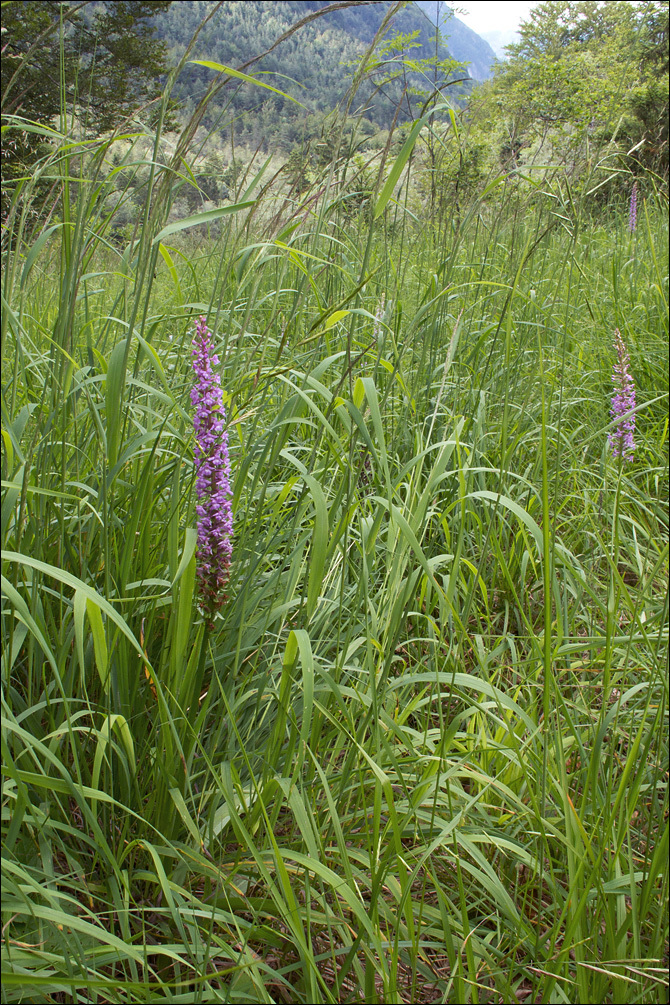
Slo.: navadni kukovinik - Habitat: grass and isolated trees (dominant Picea abies and Fagus sylvatica) overgrown alluvial deposits of a river, calcareous ground, shallow ground water, flat terrain, open fairly sunny place, high air humidity, exposed to direct rain, average precipitations ~ 3.000 mm/year, average temperature 7-9 deg C,elevation 540 m (1.770 feet), alpine phytogeographical region. - Substratum: soil. - Comment: Gymnadenia conopsea is with little doubt the most common wild orchid growing in upper Posoje. Many times it appears in large groups. One can find it almost in all habitats since it is ambivalent to ground humidity, acidity and type of ground. There is only one ground condition, which kills it - too much nitrogen in the ground, with other words too much fertilization particularly with nitrogen rich slurry. - Taxonomically, several subspecies, varieties and forms have been described, but most of them are not generally accepted. For example, tall plants with dense inflorescence and many flowers (>40 according to some authors) in it are named as Gymnadenia conopsea ssp. densiflora, Gymnadenia conopsea var. densiflora or lately on species level Gymnadenia splendida. Subspecies montana, alpina, vernalis etc. are also described. To my field experience plants differ widely in size, shape as well as in color (from pink to almost purple). On one hand, difference in habitus of a small Gymnadenia conopsea ssp. conopsea, say, 30 cm tall with 20 flowers and a plant, which is supposed to be Gymnadenia splendida, which can be over 1 m tall having very dense inflorescence with over 100 flowers is undeniable. On the other hand, one can find also all possible intermediate forms, resembling much more a continuum of forms than two (or more) distinct appearances. Be it as it may, all are beautiful. - Protected according to 'Uredba o zavarovanih prosto iveih rastlinskih vrstah', Ur.l.RS, t.46/2004 (Regulation on protected wild plants, Official gazette of Republic of Slovenia, No. 46/2004). Enlisted in the Slovene Red List of rare and endangered species, marked by 'V' representing a vulnerable species. - Ref.: (1) H. Haeupler, T. Muer, Bildatlas der Farn- und Bltenpflazen Deutschlands, Ulmer (2000), p 705. (2) H. Baumann, S. Kuenkele, R. Lorenz, Orchideen Europas, Ulmer (2006), p 104. (3) D. Aeschimann, K. Lauber, D.M. Moser, J.P. Theurillat, Flora Alpina, Vol. 2., Haupt (2004), p 1112. (4) M.A. Fischer, W. Adler, K. Oswald, Exkursionsflora sterreich Liechtenstein, Sdtirol, LO Landesmuseen, Linz, Austria (2005), p 1041. (5) A. Martini et all., Mala Flora Slovenije, Tehnina Zaloba Slovenije (2007) (in Slovene), p 773. Picture file names: from Gymnadenia-conopsea-conopsea_raw_30.xxx to Gymnadenia-conopsea-conopsea_raw_39.xxx.
-
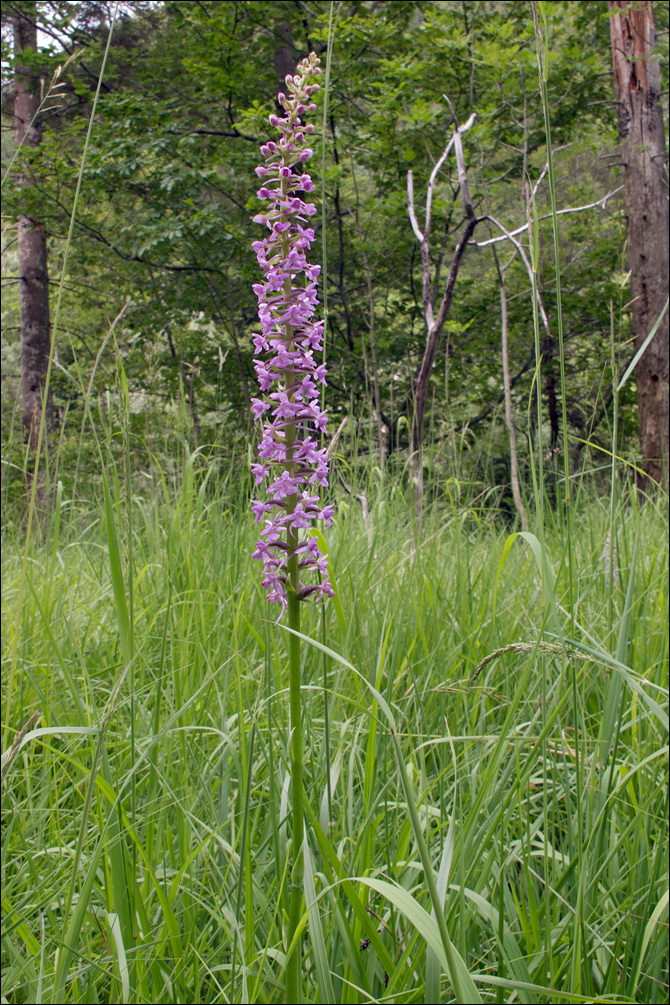
Slo.: navadni kukovinik - Habitat: grass and isolated trees (dominant Picea abies and Fagus sylvatica) overgrown alluvial deposits of a river, calcareous ground, shallow ground water, flat terrain, open fairly sunny place, high air humidity, exposed to direct rain, average precipitations ~ 3.000 mm/year, average temperature 7-9 deg C,elevation 540 m (1.770 feet), alpine phytogeographical region. - Substratum: soil. - Comment: Gymnadenia conopsea is with little doubt the most common wild orchid growing in upper Posoje. Many times it appears in large groups. One can find it almost in all habitats since it is ambivalent to ground humidity, acidity and type of ground. There is only one ground condition, which kills it - too much nitrogen in the ground, with other words too much fertilization particularly with nitrogen rich slurry. - Taxonomically, several subspecies, varieties and forms have been described, but most of them are not generally accepted. For example, tall plants with dense inflorescence and many flowers (>40 according to some authors) in it are named as Gymnadenia conopsea ssp. densiflora, Gymnadenia conopsea var. densiflora or lately on species level Gymnadenia splendida. Subspecies montana, alpina, vernalis etc. are also described. To my field experience plants differ widely in size, shape as well as in color (from pink to almost purple). On one hand, difference in habitus of a small Gymnadenia conopsea ssp. conopsea, say, 30 cm tall with 20 flowers and a plant, which is supposed to be Gymnadenia splendida, which can be over 1 m tall having very dense inflorescence with over 100 flowers is undeniable. On the other hand, one can find also all possible intermediate forms, resembling much more a continuum of forms than two (or more) distinct appearances. Be it as it may, all are beautiful. - Protected according to 'Uredba o zavarovanih prosto iveih rastlinskih vrstah', Ur.l.RS, t.46/2004 (Regulation on protected wild plants, Official gazette of Republic of Slovenia, No. 46/2004). Enlisted in the Slovene Red List of rare and endangered species, marked by 'V' representing a vulnerable species. - Ref.: (1) H. Haeupler, T. Muer, Bildatlas der Farn- und Bltenpflazen Deutschlands, Ulmer (2000), p 705. (2) H. Baumann, S. Kuenkele, R. Lorenz, Orchideen Europas, Ulmer (2006), p 104. (3) D. Aeschimann, K. Lauber, D.M. Moser, J.P. Theurillat, Flora Alpina, Vol. 2., Haupt (2004), p 1112. (4) M.A. Fischer, W. Adler, K. Oswald, Exkursionsflora sterreich Liechtenstein, Sdtirol, LO Landesmuseen, Linz, Austria (2005), p 1041. (5) A. Martini et all., Mala Flora Slovenije, Tehnina Zaloba Slovenije (2007) (in Slovene), p 773. Picture file names: from Gymnadenia-conopsea-conopsea_raw_30.xxx to Gymnadenia-conopsea-conopsea_raw_39.xxx.
-
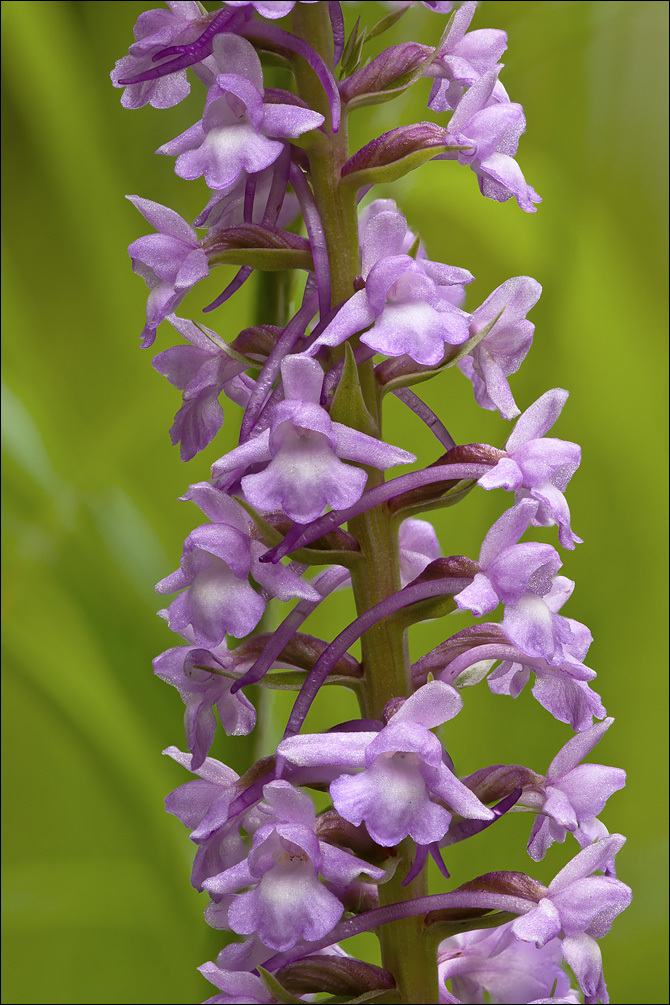
Slo.: navadni kukovinik - Habitat: grass and isolated trees (dominant Picea abies and Fagus sylvatica) overgrown alluvial deposits of a river, calcareous ground, shallow ground water, flat terrain, open fairly sunny place, high air humidity, exposed to direct rain, average precipitations ~ 3.000 mm/year, average temperature 7-9 deg C,elevation 540 m (1.770 feet), alpine phytogeographical region. - Substratum: soil. - Comment: Gymnadenia conopsea is with little doubt the most common wild orchid growing in upper Posoje. Many times it appears in large groups. One can find it almost in all habitats since it is ambivalent to ground humidity, acidity and type of ground. There is only one ground condition, which kills it - too much nitrogen in the ground, with other words too much fertilization particularly with nitrogen rich slurry. - Taxonomically, several subspecies, varieties and forms have been described, but most of them are not generally accepted. For example, tall plants with dense inflorescence and many flowers (>40 according to some authors) in it are named as Gymnadenia conopsea ssp. densiflora, Gymnadenia conopsea var. densiflora or lately on species level Gymnadenia splendida. Subspecies montana, alpina, vernalis etc. are also described. To my field experience plants differ widely in size, shape as well as in color (from pink to almost purple). On one hand, difference in habitus of a small Gymnadenia conopsea ssp. conopsea, say, 30 cm tall with 20 flowers and a plant, which is supposed to be Gymnadenia splendida, which can be over 1 m tall having very dense inflorescence with over 100 flowers is undeniable. On the other hand, one can find also all possible intermediate forms, resembling much more a continuum of forms than two (or more) distinct appearances. Be it as it may, all are beautiful. - Protected according to 'Uredba o zavarovanih prosto iveih rastlinskih vrstah', Ur.l.RS, t.46/2004 (Regulation on protected wild plants, Official gazette of Republic of Slovenia, No. 46/2004). Enlisted in the Slovene Red List of rare and endangered species, marked by 'V' representing a vulnerable species. - Ref.: (1) H. Haeupler, T. Muer, Bildatlas der Farn- und Bltenpflazen Deutschlands, Ulmer (2000), p 705. (2) H. Baumann, S. Kuenkele, R. Lorenz, Orchideen Europas, Ulmer (2006), p 104. (3) D. Aeschimann, K. Lauber, D.M. Moser, J.P. Theurillat, Flora Alpina, Vol. 2., Haupt (2004), p 1112. (4) M.A. Fischer, W. Adler, K. Oswald, Exkursionsflora sterreich Liechtenstein, Sdtirol, LO Landesmuseen, Linz, Austria (2005), p 1041. (5) A. Martini et all., Mala Flora Slovenije, Tehnina Zaloba Slovenije (2007) (in Slovene), p 773. Picture file names: from Gymnadenia-conopsea-conopsea_raw_30.xxx to Gymnadenia-conopsea-conopsea_raw_39.xxx.
-

Slo.: navadni kukovinik - Habitat: grass and isolated trees (dominant Picea abies and Fagus sylvatica) overgrown alluvial deposits of a river, calcareous ground, shallow ground water, flat terrain, open fairly sunny place, high air humidity, exposed to direct rain, average precipitations ~ 3.000 mm/year, average temperature 7-9 deg C,elevation 540 m (1.770 feet), alpine phytogeographical region. - Substratum: soil. - Comment: Gymnadenia conopsea is with little doubt the most common wild orchid growing in upper Posoje. Many times it appears in large groups. One can find it almost in all habitats since it is ambivalent to ground humidity, acidity and type of ground. There is only one ground condition, which kills it - too much nitrogen in the ground, with other words too much fertilization particularly with nitrogen rich slurry. - Taxonomically, several subspecies, varieties and forms have been described, but most of them are not generally accepted. For example, tall plants with dense inflorescence and many flowers (>40 according to some authors) in it are named as Gymnadenia conopsea ssp. densiflora, Gymnadenia conopsea var. densiflora or lately on species level Gymnadenia splendida. Subspecies montana, alpina, vernalis etc. are also described. To my field experience plants differ widely in size, shape as well as in color (from pink to almost purple). On one hand, difference in habitus of a small Gymnadenia conopsea ssp. conopsea, say, 30 cm tall with 20 flowers and a plant, which is supposed to be Gymnadenia splendida, which can be over 1 m tall having very dense inflorescence with over 100 flowers is undeniable. On the other hand, one can find also all possible intermediate forms, resembling much more a continuum of forms than two (or more) distinct appearances. Be it as it may, all are beautiful. - Protected according to 'Uredba o zavarovanih prosto iveih rastlinskih vrstah', Ur.l.RS, t.46/2004 (Regulation on protected wild plants, Official gazette of Republic of Slovenia, No. 46/2004). Enlisted in the Slovene Red List of rare and endangered species, marked by 'V' representing a vulnerable species. - Ref.: (1) H. Haeupler, T. Muer, Bildatlas der Farn- und Bltenpflazen Deutschlands, Ulmer (2000), p 705. (2) H. Baumann, S. Kuenkele, R. Lorenz, Orchideen Europas, Ulmer (2006), p 104. (3) D. Aeschimann, K. Lauber, D.M. Moser, J.P. Theurillat, Flora Alpina, Vol. 2., Haupt (2004), p 1112. (4) M.A. Fischer, W. Adler, K. Oswald, Exkursionsflora sterreich Liechtenstein, Sdtirol, LO Landesmuseen, Linz, Austria (2005), p 1041. (5) A. Martini et all., Mala Flora Slovenije, Tehnina Zaloba Slovenije (2007) (in Slovene), p 773. Picture file names: from Gymnadenia-conopsea-conopsea_raw_30.xxx to Gymnadenia-conopsea-conopsea_raw_39.xxx.
-
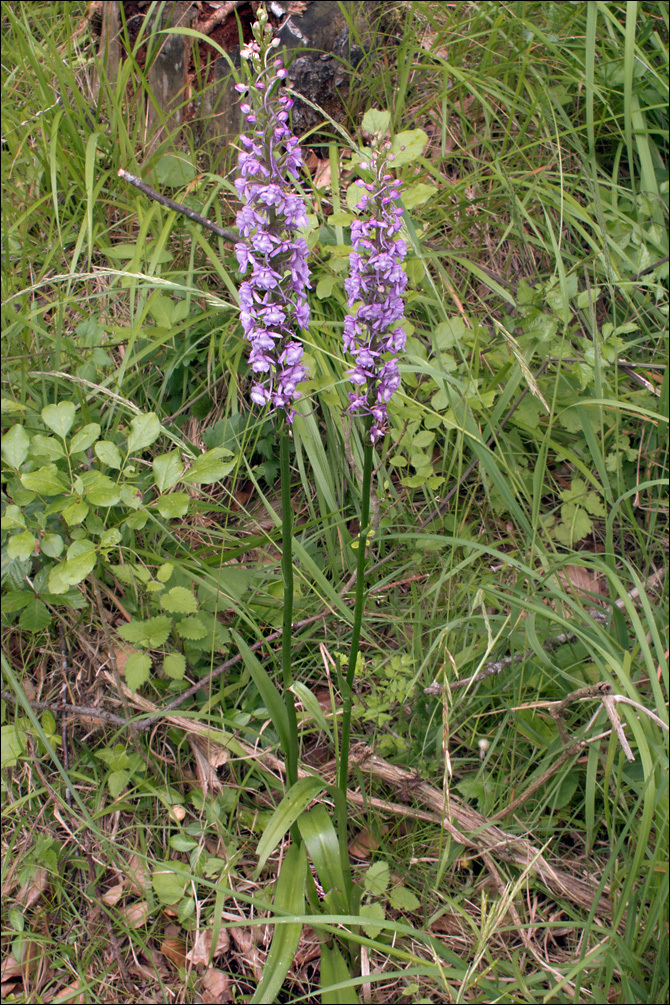
Slo.: navadni kukovinik - Habitat: grass and isolated trees (dominant Picea abies and Fagus sylvatica) overgrown alluvial deposits of a river, calcareous ground, shallow ground water, flat terrain, open fairly sunny place, high air humidity, exposed to direct rain, average precipitations ~ 3.000 mm/year, average temperature 7-9 deg C,elevation 540 m (1.770 feet), alpine phytogeographical region. - Substratum: soil. - Comment: Gymnadenia conopsea is with little doubt the most common wild orchid growing in upper Posoje. Many times it appears in large groups. One can find it almost in all habitats since it is ambivalent to ground humidity, acidity and type of ground. There is only one ground condition, which kills it - too much nitrogen in the ground, with other words too much fertilization particularly with nitrogen rich slurry. - Taxonomically, several subspecies, varieties and forms have been described, but most of them are not generally accepted. For example, tall plants with dense inflorescence and many flowers (>40 according to some authors) in it are named as Gymnadenia conopsea ssp. densiflora, Gymnadenia conopsea var. densiflora or lately on species level Gymnadenia splendida. Subspecies montana, alpina, vernalis etc. are also described. To my field experience plants differ widely in size, shape as well as in color (from pink to almost purple). On one hand, difference in habitus of a small Gymnadenia conopsea ssp. conopsea, say, 30 cm tall with 20 flowers and a plant, which is supposed to be Gymnadenia splendida, which can be over 1 m tall having very dense inflorescence with over 100 flowers is undeniable. On the other hand, one can find also all possible intermediate forms, resembling much more a continuum of forms than two (or more) distinct appearances. Be it as it may, all are beautiful. - Protected according to 'Uredba o zavarovanih prosto iveih rastlinskih vrstah', Ur.l.RS, t.46/2004 (Regulation on protected wild plants, Official gazette of Republic of Slovenia, No. 46/2004). Enlisted in the Slovene Red List of rare and endangered species, marked by 'V' representing a vulnerable species. - Ref.: (1) H. Haeupler, T. Muer, Bildatlas der Farn- und Bltenpflazen Deutschlands, Ulmer (2000), p 705. (2) H. Baumann, S. Kuenkele, R. Lorenz, Orchideen Europas, Ulmer (2006), p 104. (3) D. Aeschimann, K. Lauber, D.M. Moser, J.P. Theurillat, Flora Alpina, Vol. 2., Haupt (2004), p 1112. (4) M.A. Fischer, W. Adler, K. Oswald, Exkursionsflora sterreich Liechtenstein, Sdtirol, LO Landesmuseen, Linz, Austria (2005), p 1041. (5) A. Martini et all., Mala Flora Slovenije, Tehnina Zaloba Slovenije (2007) (in Slovene), p 773. Picture file names: from Gymnadenia-conopsea-conopsea_raw_30.xxx to Gymnadenia-conopsea-conopsea_raw_39.xxx.
-
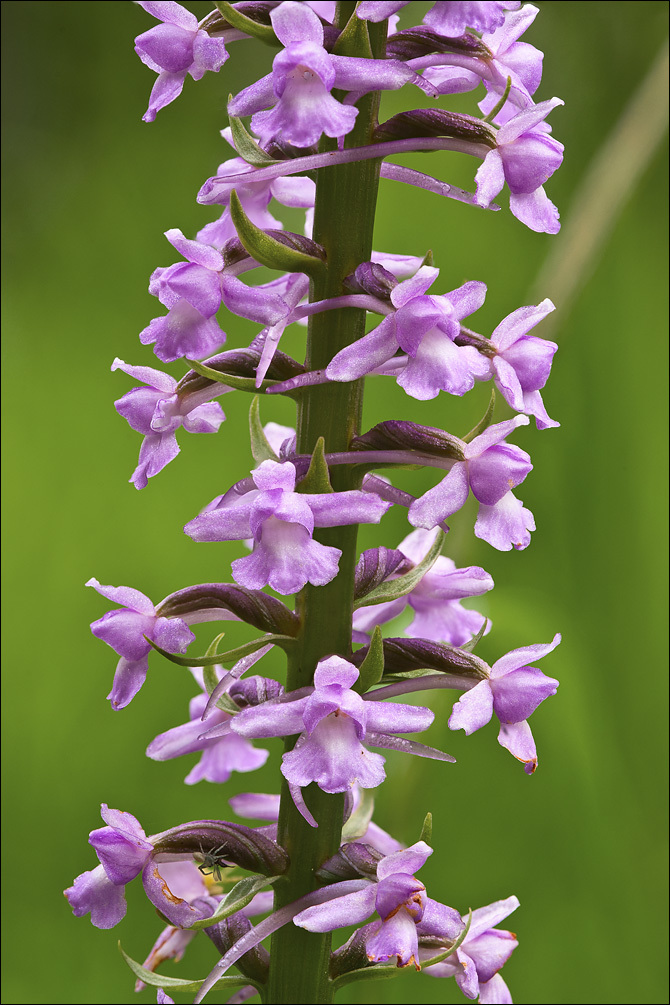
Slo.: navadni kukovinik - Habitat: grass and isolated trees (dominant Picea abies and Fagus sylvatica) overgrown alluvial deposits of a river, calcareous ground, shallow ground water, flat terrain, open fairly sunny place, high air humidity, exposed to direct rain, average precipitations ~ 3.000 mm/year, average temperature 7-9 deg C,elevation 540 m (1.770 feet), alpine phytogeographical region. - Substratum: soil. - Comment: Gymnadenia conopsea is with little doubt the most common wild orchid growing in upper Posoje. Many times it appears in large groups. One can find it almost in all habitats since it is ambivalent to ground humidity, acidity and type of ground. There is only one ground condition, which kills it - too much nitrogen in the ground, with other words too much fertilization particularly with nitrogen rich slurry. - Taxonomically, several subspecies, varieties and forms have been described, but most of them are not generally accepted. For example, tall plants with dense inflorescence and many flowers (>40 according to some authors) in it are named as Gymnadenia conopsea ssp. densiflora, Gymnadenia conopsea var. densiflora or lately on species level Gymnadenia splendida. Subspecies montana, alpina, vernalis etc. are also described. To my field experience plants differ widely in size, shape as well as in color (from pink to almost purple). On one hand, difference in habitus of a small Gymnadenia conopsea ssp. conopsea, say, 30 cm tall with 20 flowers and a plant, which is supposed to be Gymnadenia splendida, which can be over 1 m tall having very dense inflorescence with over 100 flowers is undeniable. On the other hand, one can find also all possible intermediate forms, resembling much more a continuum of forms than two (or more) distinct appearances. Be it as it may, all are beautiful. - Protected according to 'Uredba o zavarovanih prosto iveih rastlinskih vrstah', Ur.l.RS, t.46/2004 (Regulation on protected wild plants, Official gazette of Republic of Slovenia, No. 46/2004). Enlisted in the Slovene Red List of rare and endangered species, marked by 'V' representing a vulnerable species. - Ref.: (1) H. Haeupler, T. Muer, Bildatlas der Farn- und Bltenpflazen Deutschlands, Ulmer (2000), p 705. (2) H. Baumann, S. Kuenkele, R. Lorenz, Orchideen Europas, Ulmer (2006), p 104. (3) D. Aeschimann, K. Lauber, D.M. Moser, J.P. Theurillat, Flora Alpina, Vol. 2., Haupt (2004), p 1112. (4) M.A. Fischer, W. Adler, K. Oswald, Exkursionsflora sterreich Liechtenstein, Sdtirol, LO Landesmuseen, Linz, Austria (2005), p 1041. (5) A. Martini et all., Mala Flora Slovenije, Tehnina Zaloba Slovenije (2007) (in Slovene), p 773. Picture file names: from Gymnadenia-conopsea-conopsea_raw_30.xxx to Gymnadenia-conopsea-conopsea_raw_39.xxx.
-
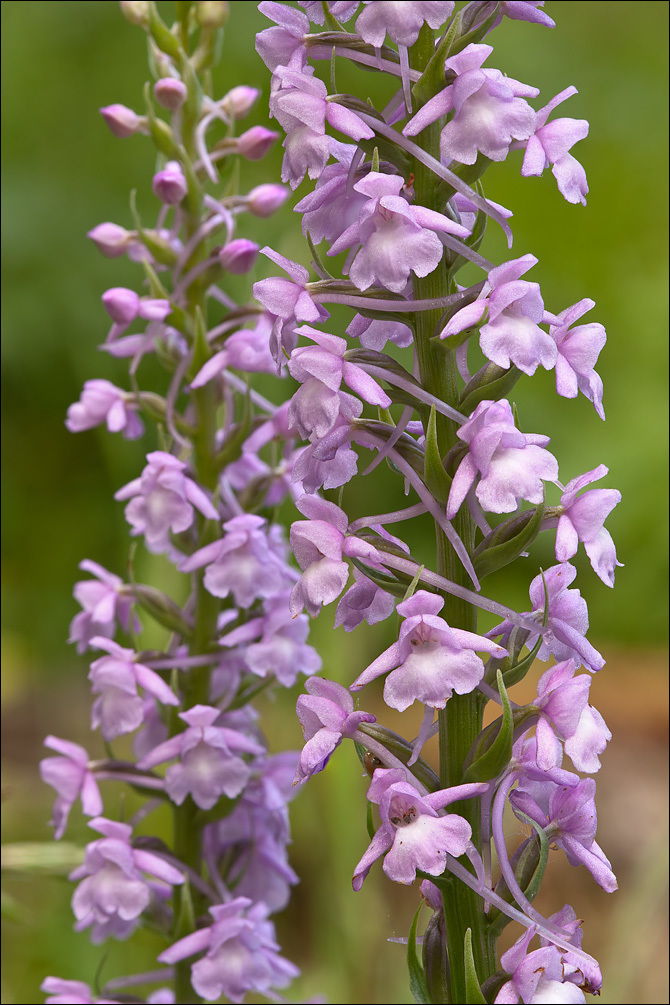
Slo.: navadni kukovinik - Habitat: grass and isolated trees (dominant Picea abies and Fagus sylvatica) overgrown alluvial deposits of a river, calcareous ground, shallow ground water, flat terrain, open fairly sunny place, high air humidity, exposed to direct rain, average precipitations ~ 3.000 mm/year, average temperature 7-9 deg C,elevation 540 m (1.770 feet), alpine phytogeographical region. - Substratum: soil. - Comment: Gymnadenia conopsea is with little doubt the most common wild orchid growing in upper Posoje. Many times it appears in large groups. One can find it almost in all habitats since it is ambivalent to ground humidity, acidity and type of ground. There is only one ground condition, which kills it - too much nitrogen in the ground, with other words too much fertilization particularly with nitrogen rich slurry. - Taxonomically, several subspecies, varieties and forms have been described, but most of them are not generally accepted. For example, tall plants with dense inflorescence and many flowers (>40 according to some authors) in it are named as Gymnadenia conopsea ssp. densiflora, Gymnadenia conopsea var. densiflora or lately on species level Gymnadenia splendida. Subspecies montana, alpina, vernalis etc. are also described. To my field experience plants differ widely in size, shape as well as in color (from pink to almost purple). On one hand, difference in habitus of a small Gymnadenia conopsea ssp. conopsea, say, 30 cm tall with 20 flowers and a plant, which is supposed to be Gymnadenia splendida, which can be over 1 m tall having very dense inflorescence with over 100 flowers is undeniable. On the other hand, one can find also all possible intermediate forms, resembling much more a continuum of forms than two (or more) distinct appearances. Be it as it may, all are beautiful. - Protected according to 'Uredba o zavarovanih prosto iveih rastlinskih vrstah', Ur.l.RS, t.46/2004 (Regulation on protected wild plants, Official gazette of Republic of Slovenia, No. 46/2004). Enlisted in the Slovene Red List of rare and endangered species, marked by 'V' representing a vulnerable species. - Ref.: (1) H. Haeupler, T. Muer, Bildatlas der Farn- und Bltenpflazen Deutschlands, Ulmer (2000), p 705. (2) H. Baumann, S. Kuenkele, R. Lorenz, Orchideen Europas, Ulmer (2006), p 104. (3) D. Aeschimann, K. Lauber, D.M. Moser, J.P. Theurillat, Flora Alpina, Vol. 2., Haupt (2004), p 1112. (4) M.A. Fischer, W. Adler, K. Oswald, Exkursionsflora sterreich Liechtenstein, Sdtirol, LO Landesmuseen, Linz, Austria (2005), p 1041. (5) A. Martini et all., Mala Flora Slovenije, Tehnina Zaloba Slovenije (2007) (in Slovene), p 773. Picture file names: from Gymnadenia-conopsea-conopsea_raw_30.xxx to Gymnadenia-conopsea-conopsea_raw_39.xxx.
-
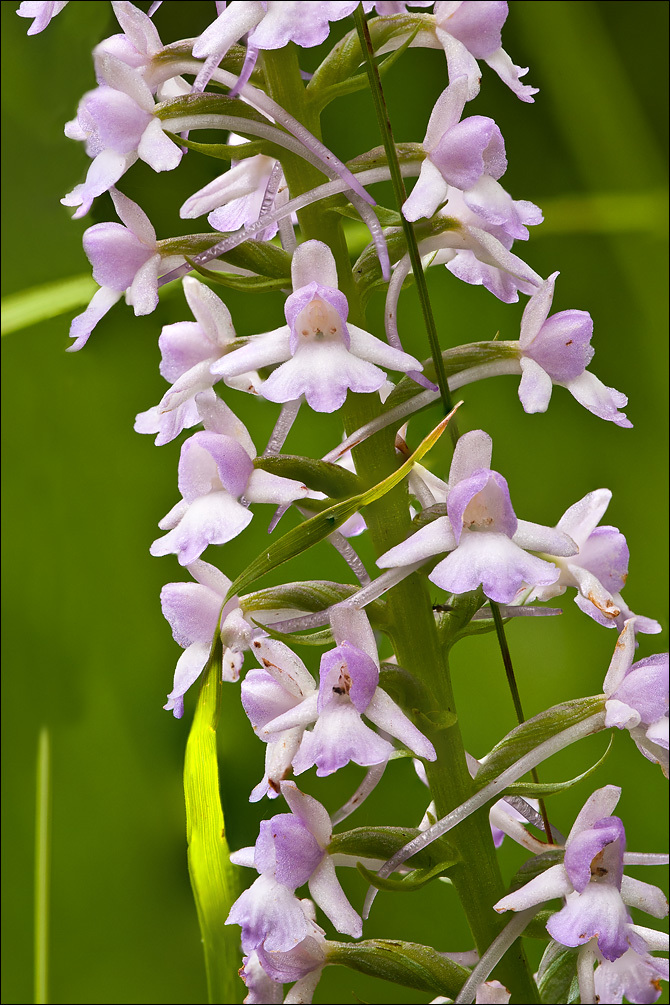
Slo.: navadni kukovinik - Habitat: grass and isolated trees (dominant Picea abies and Fagus sylvatica) overgrown alluvial deposits of a river, calcareous ground, shallow ground water, flat terrain, open fairly sunny place, high air humidity, exposed to direct rain, average precipitations ~ 3.000 mm/year, average temperature 7-9 deg C,elevation 540 m (1.770 feet), alpine phytogeographical region. - Substratum: soil. - Comment: Gymnadenia conopsea is with little doubt the most common wild orchid growing in upper Posoje. Many times it appears in large groups. One can find it almost in all habitats since it is ambivalent to ground humidity, acidity and type of ground. There is only one ground condition, which kills it - too much nitrogen in the ground, with other words too much fertilization particularly with nitrogen rich slurry. - Taxonomically, several subspecies, varieties and forms have been described, but most of them are not generally accepted. For example, tall plants with dense inflorescence and many flowers (>40 according to some authors) in it are named as Gymnadenia conopsea ssp. densiflora, Gymnadenia conopsea var. densiflora or lately on species level Gymnadenia splendida. Subspecies montana, alpina, vernalis etc. are also described. To my field experience plants differ widely in size, shape as well as in color (from pink to almost purple). On one hand, difference in habitus of a small Gymnadenia conopsea ssp. conopsea, say, 30 cm tall with 20 flowers and a plant, which is supposed to be Gymnadenia splendida, which can be over 1 m tall having very dense inflorescence with over 100 flowers is undeniable. On the other hand, one can find also all possible intermediate forms, resembling much more a continuum of forms than two (or more) distinct appearances. Be it as it may, all are beautiful. - Protected according to 'Uredba o zavarovanih prosto iveih rastlinskih vrstah', Ur.l.RS, t.46/2004 (Regulation on protected wild plants, Official gazette of Republic of Slovenia, No. 46/2004). Enlisted in the Slovene Red List of rare and endangered species, marked by 'V' representing a vulnerable species. - Ref.: (1) H. Haeupler, T. Muer, Bildatlas der Farn- und Bltenpflazen Deutschlands, Ulmer (2000), p 705. (2) H. Baumann, S. Kuenkele, R. Lorenz, Orchideen Europas, Ulmer (2006), p 104. (3) D. Aeschimann, K. Lauber, D.M. Moser, J.P. Theurillat, Flora Alpina, Vol. 2., Haupt (2004), p 1112. (4) M.A. Fischer, W. Adler, K. Oswald, Exkursionsflora sterreich Liechtenstein, Sdtirol, LO Landesmuseen, Linz, Austria (2005), p 1041. (5) A. Martini et all., Mala Flora Slovenije, Tehnina Zaloba Slovenije (2007) (in Slovene), p 773. Picture file names: from Gymnadenia-conopsea-conopsea_raw_30.xxx to Gymnadenia-conopsea-conopsea_raw_39.xxx.
-
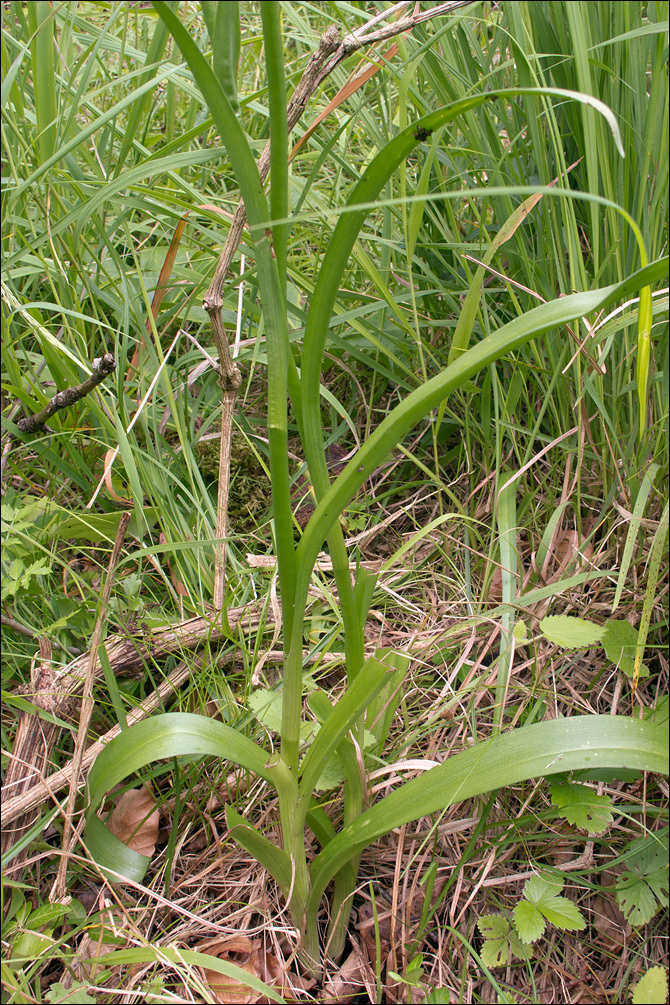
Slo.: navadni kukovinik - Habitat: grass and isolated trees (dominant Picea abies and Fagus sylvatica) overgrown alluvial deposits of a river, calcareous ground, shallow ground water, flat terrain, open fairly sunny place, high air humidity, exposed to direct rain, average precipitations ~ 3.000 mm/year, average temperature 7-9 deg C,elevation 540 m (1.770 feet), alpine phytogeographical region. - Substratum: soil. - Comment: Gymnadenia conopsea is with little doubt the most common wild orchid growing in upper Posoje. Many times it appears in large groups. One can find it almost in all habitats since it is ambivalent to ground humidity, acidity and type of ground. There is only one ground condition, which kills it - too much nitrogen in the ground, with other words too much fertilization particularly with nitrogen rich slurry. - Taxonomically, several subspecies, varieties and forms have been described, but most of them are not generally accepted. For example, tall plants with dense inflorescence and many flowers (>40 according to some authors) in it are named as Gymnadenia conopsea ssp. densiflora, Gymnadenia conopsea var. densiflora or lately on species level Gymnadenia splendida. Subspecies montana, alpina, vernalis etc. are also described. To my field experience plants differ widely in size, shape as well as in color (from pink to almost purple). On one hand, difference in habitus of a small Gymnadenia conopsea ssp. conopsea, say, 30 cm tall with 20 flowers and a plant, which is supposed to be Gymnadenia splendida, which can be over 1 m tall having very dense inflorescence with over 100 flowers is undeniable. On the other hand, one can find also all possible intermediate forms, resembling much more a continuum of forms than two (or more) distinct appearances. Be it as it may, all are beautiful. - Protected according to 'Uredba o zavarovanih prosto iveih rastlinskih vrstah', Ur.l.RS, t.46/2004 (Regulation on protected wild plants, Official gazette of Republic of Slovenia, No. 46/2004). Enlisted in the Slovene Red List of rare and endangered species, marked by 'V' representing a vulnerable species. - Ref.: (1) H. Haeupler, T. Muer, Bildatlas der Farn- und Bltenpflazen Deutschlands, Ulmer (2000), p 705. (2) H. Baumann, S. Kuenkele, R. Lorenz, Orchideen Europas, Ulmer (2006), p 104. (3) D. Aeschimann, K. Lauber, D.M. Moser, J.P. Theurillat, Flora Alpina, Vol. 2., Haupt (2004), p 1112. (4) M.A. Fischer, W. Adler, K. Oswald, Exkursionsflora sterreich Liechtenstein, Sdtirol, LO Landesmuseen, Linz, Austria (2005), p 1041. (5) A. Martini et all., Mala Flora Slovenije, Tehnina Zaloba Slovenije (2007) (in Slovene), p 773. Picture file names: from Gymnadenia-conopsea-conopsea_raw_30.xxx to Gymnadenia-conopsea-conopsea_raw_39.xxx.
-
The Tskhratskaro Pass above the resort Village of Bakuriani was also amazing, lors of flowers and buytterflies...anobody can name this one ???
-
-
-

